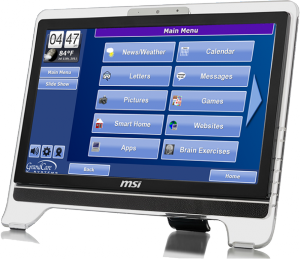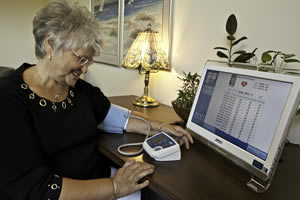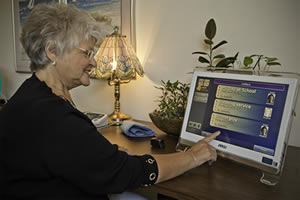I read an article today from Health Day News via Caring.com called “For Many Americans, Caregiving a Long Distance Burden” (see an excerpt below)
The article makes some really great points on the trials and tribulations of being a long distance caregiver and also gives some helpful resources and facts. However, the article was missing the entire technology component that now enables long distance and virtual care. Technology is a critical tool for caregivers to use, especially when not all of the caregivers can physically be there. Technology can help to ease the burden of local caregivers, allowing them to “share the care” with long distance caregivers and family members. Long Distance caregivers can now be involved and have equal access to the information, virtually. For example, the GrandCare System allows family members (near and far) to log into the GrandCare dashboard and check on how that person is doing, make sure the living environment is ok, make sure the loved one is performing the correct activities of daily living, taking meds at correct times, eating, etc.
Systems like GrandCare also enables a new world of communication between all of the caregivers and the loved one. A built in web cam on the resident’s GrandCare System allows the loved one and family to participate in video chat sessions and also enables family to send pictures, messages, emails, reminders, calendar appointments and more to an interactive, simple touch interface. Family can also send fun videos and music. The resident doesn’t need to know anything about technology to enjoy this.
Technology is playing a vital role in caring for a loved one (near or far) and coordinating care between multiple siblings. We have come into an age where you don’t have to physically always be there to participate in care and as a long distance caregiver, using the GrandCare sensors, you can make an educated decision on a loved one’s needs.
For Many Americans, Caregiving a Long-Distance Burden
WEDNESDAY, Aug. 31 (HealthDay News) — Caring for a parent or relative in the same zip code can be hard enough, but long-distance caregiving, which is becoming more common in an increasingly mobile society, brings with it added burdens.
By 2012, an estimated 14 million Americans will be long-distance caregivers, so many that some even have new names: “seagulls” and “pigeons.”
These terms refer to family members who alight for short periods of time, make a mess for local caregivers and fly out. What they don’t take into account are the pain, isolation and hassles that long-distance caregivers are dealing with on their own.
“They have unique issues,” said Polly Mazanec, lead author of a paper appearing in a recent issue of Oncology Nursing Forum.
Those include financial concerns, since many people are borrowing from savings to travel at a moment’s notice or to arrange child care or pet sitting during their absence, as well as emotional issues such as guilt, worry and anxiety.
“We found that long-distance caregivers were much more anxious than local caregivers, who could see what was happening [on a more frequent basis],” said Mazanec, an assistant professor of nursing at the Frances Payne Bolton School of Nursing at Case Western Reserve University in Cleveland.
“Long-distance caregivers end up feeling guilty. I deal with it on a daily basis,” added Dr. Nasiya Ahmed, an assistant professor of geriatric and palliative medicine at the University of Texas Health Science Center at Houston.
Family caregiving has received a lot of attention recently, but not so much for those who have to do it at a distance.
“Here’s this whole group of people out there that no one is helping and they’re typically part of the sandwich generation, juggling their own families and careers,” said Mazanec, who is also an advance practice oncology nurse at University Hospital’s Case Medical Centers Seidman Cancer Center. “It’s just a real challenge.”
… to read the entire article, click here
 Steve Shefveland is a 20-year sales and marketing veteran, who is founder and CEO of Ashesi Global Services, Inc. and Tree Rings, LLC, headquartered in Phoenix, Arizona. Tree Rings was founded in 2009 and employs “boomers” and senior adults in its call centers near retirement communities to provide customer care, sales and technical support services for companies selling to the aging adult population. Mr. Shefveland attributes Tree Rings’ success to his direct investment in senior adults, whose experience and skills are highly valued for achieving the company’s vision of serving others.
Steve Shefveland is a 20-year sales and marketing veteran, who is founder and CEO of Ashesi Global Services, Inc. and Tree Rings, LLC, headquartered in Phoenix, Arizona. Tree Rings was founded in 2009 and employs “boomers” and senior adults in its call centers near retirement communities to provide customer care, sales and technical support services for companies selling to the aging adult population. Mr. Shefveland attributes Tree Rings’ success to his direct investment in senior adults, whose experience and skills are highly valued for achieving the company’s vision of serving others.


 The GrandCare system was the first system to combine socialization, activities of daily living (ADLs) and telehealth monitoring, which together provide peace of mind for family members living close by or long distance. With “wireless” Bluetooth, X10 and ZWave sensors throughout the home, family and caregivers can monitor the senior’s health and home. No computer skills are needed to operate the easy to use senior home care solution that features an interactive touch screen. Designated caregivers and family can log into the GrandCare website and access sensor graphs, vitals and set up parameters/rules to receive alerts if specific events occur such as medications are not taken, a door is opened at odd times, a refrigerator is not accessed at meal time or an individual did not get out of bed.
The GrandCare system was the first system to combine socialization, activities of daily living (ADLs) and telehealth monitoring, which together provide peace of mind for family members living close by or long distance. With “wireless” Bluetooth, X10 and ZWave sensors throughout the home, family and caregivers can monitor the senior’s health and home. No computer skills are needed to operate the easy to use senior home care solution that features an interactive touch screen. Designated caregivers and family can log into the GrandCare website and access sensor graphs, vitals and set up parameters/rules to receive alerts if specific events occur such as medications are not taken, a door is opened at odd times, a refrigerator is not accessed at meal time or an individual did not get out of bed.
 …
…
